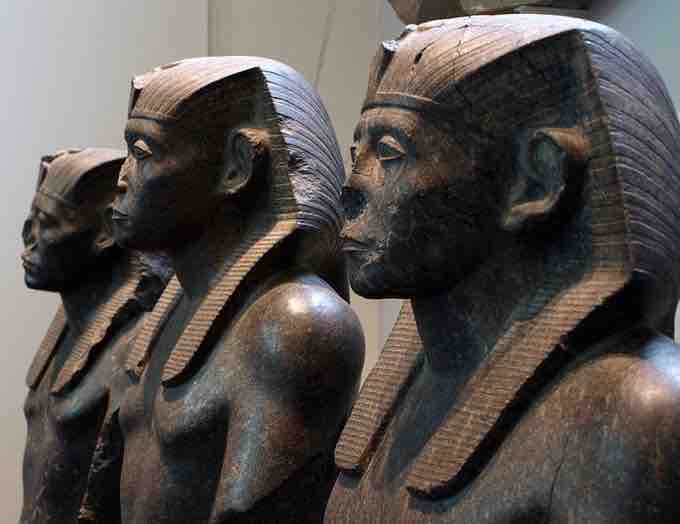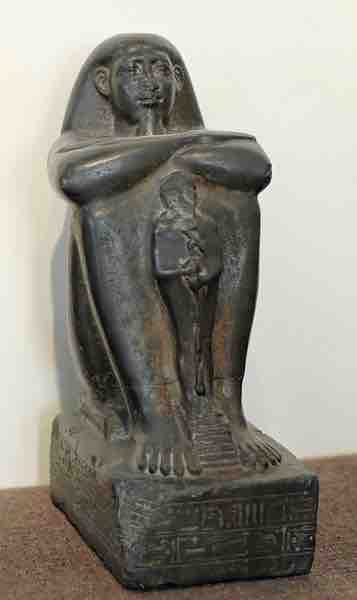Mentuhotep II
The Middle Kingdom (c. 2000-1650 BCE) was marked by the reunification of Egypt following a period of weak pharaonic power and civil war called the First Intermediate. Mentuhotep II restored stability in 2041 BCE after launching an attack that met with little resistance. After toppling the last rulers of the Tenth Dynasty, Mentuhotep II began consolidating his power over all Egypt, completing the process circa 2000 BCE. His subjects considered him to be divine or semi-divine, as suggested in a relief depicting the pharaoh receiving offerings.
Mentuhotep II receiving offerings
Mentuhotep II, seated, holds the crook as a symbol of power.
Senusret III
During the Middle Kingdom, relief and portrait sculpture captured subtle, individual details that reached new heights of technical perfection. Some of the finest examples of sculpture during this time was at the height of the empire under Pharaoh Senusret III.
Senusret III (also written as Senwosret III or Sesostris III) ruled from 1878–1839 BCE and was the fifth monarch of the Twelfth Dynasty of the Middle Kingdom. His military campaigns gave rise to an era of peace and economic prosperity that not only reduced the power of regional rulers, but also led to a revival in craftwork, trade, and urban development in the Egyptian kingdom. One of the few kings who were deified and honored with a cult during their own lifetime, he is considered to be perhaps the most powerful Egyptian ruler of the dynasty.

Head of pharaoh Sesostris III, made of red granite, circa 1850 BCE
Some of the sculptures of Senusret III, like this one, portray him as an aging man—a style that deviated from the standard representation of kings.
Aside from his accomplishments in architecture and war, Senusret III is known for his strikingly somber sculptures in which he appears careworn and grave. Deviating from the standard way of representing kings, Senusret III and his successor Amenemhat III had themselves portrayed as mature, aging men. This is often interpreted as a portrayal of the burden of power and kingship. The change in representation as ideological, and not something to be interpreted as the portrayal of an aging king, is shown by the fact that in one single relief, Senusret III was represented as a vigorous young man, following the centuries old tradition, and as a mature aging king.

Three black granite statues of the pharaoh Sesotris III, seen in right profile (Twelfth Dynasty, circa 1850 BCE)
Senusret III is known for his strikingly somber sculptures.
Block Statues and Women Patrons
Another important innovation in sculpture that occurred during the Middle Kingdom was the block statue, which would continue to be popular through to the Ptolemaic age almost 2,000 years later. Block statues consist of a man squatting with his knees drawn up to his chest and his arms folded on top of his knees. Often, these men are wearing a wide cloak that reduces the body of the figure to a simple block-like shape. In some cases the cloak covers the feet completely, and in others the feet are left uncovered. The head of the sculpture contains the most detail.

Example of a block statue
Block statues of the Middle Kingdom consisted of a man squatting with his knees drawn up to his chest.
The sculpture pictured below—the fact that a private woman could have a sculpture made for herself—speaks volumes for the equality of gender in ancient Egypt. The heavy tripartite wig frames the broad face and passes behind the ears, thus giving the impression of forcing them forward. They are large in keeping with the ancient Egyptian ideal of beauty; the same ideal required small breasts, and in this respect, the sculpture is no exception. Whereas the natural curve of the eyebrows dips towards the root of the nose, the artificial eyebrows in low relief are absolutely straight above the inner corners of the eyes, a feature which places the bust early in the early Twelfth Dynasty. Around 1900 BCE, these artificial eyebrows, too, began to follow the natural curve and dipped toward the nose.
Head and torso of a noblewoman (Twelfth Dynasty)
This sculpture, commissioned by a noblewoman, provides evidence of gender equality among the elite during the Middle Kingdom.